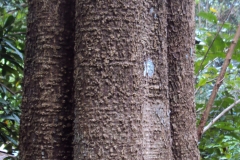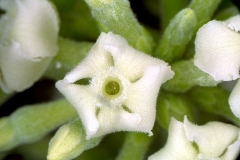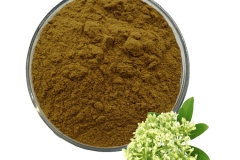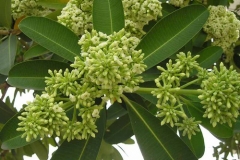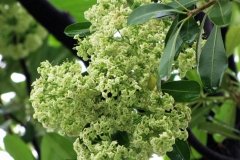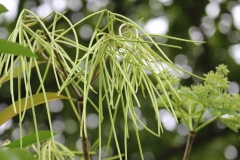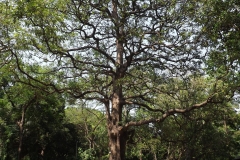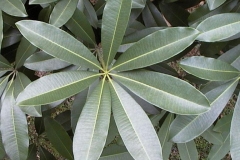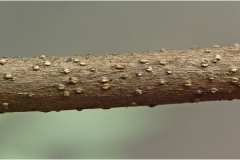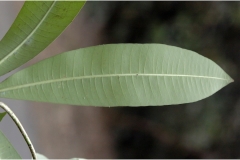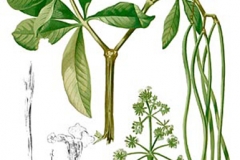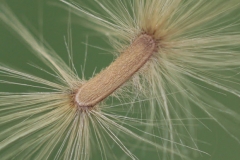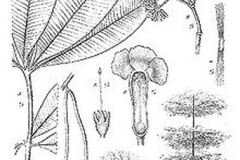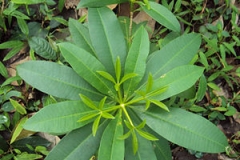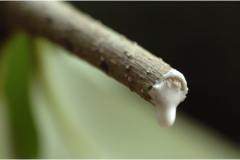| Indian devil tree Quick Facts |
| Name: |
Indian devil tree |
| Scientific Name: |
Alstonia scholaris |
| Origin |
Indian subcontinent, Malay Peninsula, and Australasia |
| Colors |
Green when young turning to brown as they matures |
| Shapes |
Pendulous, two-lobed, dehiscent follicle, brown or green, dry or woody, spindle-shaped, 15-32 cm long, 4-6 mm in diameter |
| Taste |
Bitter, astringent |
| Health benefits |
Cures recurrent and intermittent fever, Obesity & Cholesterol, Jaundice, Dandruff and Head Lice, Abscess |
Indian devil tree scientifically known as Alstonia scholaris is an evergreen tropical tree in the family Apocynaceae. The plant is native to the lowland and mountain rainforests of Indian subcontinent, Malay Peninsula, and Australasia. The plant grows throughout the humid regions of India, especially in West Bengal and west-coast forests of south India. Few of the popular common names of the plants are blackboard tree, devil tree, ditabark, milkwood-pine, saptparni, shaitan tree, white cheesewood, Milky Pine, Djetutung, White Pine, Palmira Alstonia, Pine, Milky, Pulai, Jelutong, Australian fever bark tree, Australian quinine bark tree, bitter-bark tree, blackboard tree, chatiyan wood, shaitan, chattun, chatian, chhatiwan, chatiwan, tin pet, dita, khaaniqat al-kalab, shajaratah fi asya al-harrah, scholarsi, may màn, mò cua and mùa cua. It has long being used as a traditional medicine to cure various human and livestock ailments. The plant is used in Ayurvedic, Unani and Sidhha/Tamil types of alternative medicinal systems
Genus epithet ‘Alstonia named after Scottish naturalist Dr. Charles Alston (1685-1760), who was professor of botany at University of Edinburgh, scientific writer and keeper of King’s garden at Holyrood, and one of the few botanists who resisted the Linnaean taxonomic classification when it was introduced. The species name scholaris refers to the fact that the timber of this tree has traditionally been used to make wooden slates for school children. In October small, green yet fragrant flowers appear. All parts of the tree can be considered poisonous.
Plant description
Indian devil tree is elegant evergreen, glabrous, tropical tree that grows about 40 m (130 ft.) tall. The plant is found growing in moist deciduous forests, sacred groves, in the plains, open reed areas and near river. The plant prefers fertile, moist, but well-drained soil and is tolerant of a range of soils, and have been grown successfully on shallow soils over coral. The plant has cylindrical trunk up to 125 cm in diameter, on older trees it is strongly fluted. Bark is pale brown, smooth – scaly, with large horizontal lenticels, peeling off in rectangular flakes. Inner bark is cream, yellow or straw colored, with copious white sap.
Leaves
Leaves are 4-7 in a whorl, coriaceous, elliptic-oblong, 10 to 20 centimeters long, 3 to 4.5 centimeters wide, pointed at the base, rounded at the apex, glossy green on the upper surface, white or grayish on the underside. The tip of the leaf is rounded or shortly pointed, tapering towards the base. Species is irregularly deciduous in sub-tropical range. The outer blaze is cream to yellowish in color with abundant, milky latex that flows rapidly when cut.
Flower
Flowers are small, greenish white, many in umbellate panicles; corolla tube is short, very strongly scented. The inflorescence is a much-branched terminal panicle, up to 120 cm long; flowers 7-10 mm long white, cream or green, the tube hairy, lobes sparsely or densely pubescent, 1.5-4 mm long, the left margins overlapping, strongly perfumed.
Individual flowers are lightly-scented, but fully-blooming tree emits strong heady fragrance sometimes described as reminiscent of burnt sugar. It is a rich source of nectar and is pollinated by insects like various types of butterflies and bees, which often surround flowering trees. Blooming occurs once yearly in monsoonal Asia, usually from October to March.
Fruit
Fertilized flowers are followed by thin pods that can grow up to 20 inches long. Fruit a pendulous, two-lobed, dehiscent follicle, brown or green, dry or woody, spindle-shaped, 15-32 cm long, 4-6 mm in diameter, containing numerous flat, oblong, brown seeds, 4-5 mm long and 0.9-1.2 mm broad, with a tuft of hairs 7-13 mm long at each end. The seed does not taper to a point at either end. Seeds are dispersed by wind.
Health benefits of Indian devil tree
Listed below are few of the health benefits of using Indian devil tree
1. Cures recurrent and intermittent fever
Indian devil tree’s bark is collected and its outer skin is removed by scraping. To this, small piece of garlic and cumin seeds are added in equal proportion and decoction is prepared. This is administered fourth hourly in a dose of 15-20 ml. This calms recurrent and intermittent fever effectively.
2. Obesity & Cholesterol
Fresh bark or leaves are collected and fresh juice is obtained by pounding. Preferably this is administered in early morning. This is very effective against the complaints like obesity, hyper cholesterol and lipoma.
3. Jaundice
5-10 gram of Indian devil tree’s bark is taken and fine paste is made. This is administered along with buttermilk, daily early in the morning for 5-10 days. It is found to be effective in obstructive jaundice cases.
4. Dandruff and Head Lice
Bark of the tree is taken and pounded well and coarse paste is made. To this 150 ml of sesame oil is added and heated in mild intensity of heat till complete evaporation of the water content. This is filtered and stored. This is used to apply to the scalp. This is effective against dandruff and head lice.
5. Abscess
Neem and Indian devil tree are taken and fine paste is made. This is added with little salt and warmed. This is applied as poultice in case of abscess.
Traditional uses and benefits of Indian devil tree
- Bark is used to treat asthma, heart disease, for chronic ulcers, and other ailments.
- Powder mixed with ginger is given to new mothers the first day after birthing to cleanse the blood and promote lactation.
- Bark paste is applied to boils and other sores to minimize inflammation and hasten healing.
- Bark extract made with boiling water and then mixed with Cinnamomum obtusifolium seed powder is sipped to expel intestinal parasites, such as thread worms and roundworms.
- Boiled-water bark extract is consumed to treat lung disease, sour stomach, paralysis, cerebral palsy, heart disease, asthma, fever, shooting pain, and stomachache.
- Remedies made from the components of the Devil’s tree are known for stimulating the circulatory and respiratory systems, promoting weight gain, and controlling heart disease, asthma, and skin conditions.
- Latex when applied locally to ulcers, sores, yaws, the hollow of an aching tooth, to mature abscesses or boils, to kill maggots in wounds of cattle, and to draw out thorns and splinters.
- Sap is applied to sores to stimulate healing; mixed with sesame oil and swabbed inside the ear to treat earache.
- Bark, Sap, Leaf is used in treatments for fever, weakness, paralysis, sores, aches, pains, and gastric problems including dysentery.
- Leaf is used in poultices; green leaves applied to back or dried leaves burned under beds to induce lacteal secretion.
- Infusion of young leaves taken in the morning helpful in cases of beri-beri.
- Leaf tips are taken with roasted coconut to treat stomatitis.
- Tender leaves are wilted over heat, crushed, and applied to infected sores to accelerate healing.
- Bark is mainly useful for chronic diarrhea and dysentery.
- It has also been found effectual in restoring the tone of the stomach and of the system generally in debility after fevers and other exhausting diseases.
- Milky juice of the tree is applied to ulcers.
- Decoction is applied as a wash for skin diseases, and as a gargle.
- Latex obtained from the bark has been used for treating neuralgia and toothache.
- Latex is drunk in small amounts as a poison antidote.
- It is applied to sores in order to keep maggots out.
- Poultice made from the leaves has been reported as a good remedy against skin diseases.
- An infusion of the crushed leaves is used to clean infected wounds.
- Leaves and the latex are applied externally to treat tumors.
- Bark and roots are boiled with rice and eaten by girls daily for several weeks to treat excessive vaginal discharge.
- Dried leaves of the Alstonia scholaris are used as an expectorant.
- Twigs of Alstonia scholaris is used for brushing the teeth due to its bactericidal property.
- It is also useful for treating thread worms and round worm.
- It is very good supplement that helps to improves appetite and is given to women after delivery.
- It is effective remedy to drop the fever, increases lactation and provides strength to women after delivery.
- Paste of the bark is applied over inflamed joints in chronic arthritis which provides relief to the patient.
- It is a very efficient blood purifier which provides beneficial effects for the heart.
- It is very useful for malarial fever as it is a very good anti-pyretic and giving same effect as that of quinine on fever, but has no side effects.
- It is quiet beneficial in dyspnea.
- The herb is even recommended in chronic enlargement of the spleen.
- Flower powder is used in headache for nasal administration.
- Bark is given to get relief in case of leprosy, for which an extract being prepared from the fresh bark and given with milk.
- Its Milky juice can be applied in rheumatic pains, sores, toothache, tumors and ulcers.
- Ripened fruits of Indian devil tree are found to be useful in syphilis, insanity and epilepsy.
- Decoction of Indian devil tree found to be useful in diabetes.
- Juice of Indian devil tree’s flowers with honey is useful in condition of asthma.
Ayurvedic health benefits of Indian devil tree
- Diarrhea: Prepare a decoction of Alstonia Scholaris bark. Take it, twice a day.
- Arthritis: Prepare a decoction of Alstonia Scholaris root. Take it, twice a day.
- Indigestion: Make an infusion of Alstonia Scholaris bark powder. Drink during bedtime.
- Slimy stools: Drink the infusion of Alstonia Scholaris bark powder at night.
- Fatigue: Make an infusion of Alstonia Scholaris bark powder. Filter it. Drink 2 tsp, thrice a day.
- Fever: Crush the roots of Alstonia Scholaris. Take quarter tsp with 1 cup hot water.
- Ascaris: Take powder of Alstonia Scholaris root. Take it with lukewarm water.
- Phlegm: Grind roots of Alstonia Scholaris to make powder. Have 1/4 tsp with warm water.
- Rheumatism: Take quarter tsp of Alstonia Scholaris root powder with hot water once a day. OR: Make a paste of Alstonia Scholaris bark powder. Warm and bandage it tightly on the affected area. OR: Apply the milky sap of Alstonia Scholaris locally on the affected part. OR: Use the tender leaves as poultice.
- Headache: Grind the bark of Alstonia Scholaris. Mix some water to make paste. Warm it and apply it as bandage on forehead. OR: Take tender leaves of Alstonia Scholaris. Use them as poultice. OR: Locally apply milky extract of Alstonia Scholaris on the affected parts.
- Ulcers: Prepare a thick paste of Alstonia Scholaris bark powder with water. Heat it. Apply on affected part and bandage tightly. OR: Apply sap of Alstonia Scholaris locally on the affected area. OR: Use fresh leaves of Alstonia Scholaris as poultice.
- Aphrodisiac: Alstonia Scholaris seeds have strong stimulating effect on genitals. It promotes better Erection and increases sexual potency. Prepare a decoction of Alstonia Scholaris seeds in one cup of water.
- Ulcers: Apply milky latex on ulcers.
- Diarrhea: Take powdered bark (3 teaspoon) of Devil’s tree and soak in one glass boiling water for one hour. Filter and drink 2-3 times a day.
- Indigestion, Gastritis, Slimy/Mucus stools: Take powdered bark (1/2 teaspoon) of Devil’s tree and soak in boiling water for one hour. Filter and drink once a day.
- Fever, rheumatism, scrotal hernia: Take root powder (1/4 teaspoon) in a cup of lukewarm water and drink.
- Joint pain, Rheumatism, ulcers: Prepare paste of its bark and apply at affected areas.
Other facts
- Its light wood is used for coffins in Ceylon.
- Wood close to the root of the same species is very light and of white color and is used for net floats, household utensils, trenchers, corks, etc. in Borneo.
- Wood of Alstonia scholaris has been recommended for the manufacture of pencils, as it is suitable in nature.
- In Theravada Buddhism, Bodhi by first Lord Buddha is said to have used Alstonia scholaris as the tree for achieving enlightenment.
- Tribal people are reluctant to sit or pass under this tree, for the fear of the devil on the Western Ghats.
- Bark yields a fiber.
- Yellow dye obtained from the bark is used on cotton fabrics.
- Flowers yield an essential oil.
- Wood is used for making school blackboards in Myanmar.
- Tree has been recommended as a fuel wood species for the patana lands of Sri Lanka.
- Charcoal is used as gun powder.
- Tree is sometimes planted as an ornamental.
References:
https://www.itis.gov/servlet/SingleRpt/SingleRpt?search_topic=TSN&search_value=184803#null
https://davesgarden.com/guides/pf/go/100620/
http://www.hear.org/pier/species/alstonia_scholaris.htm
https://npgsweb.ars-grin.gov/gringlobal/taxonomydetail.aspx?id=2688
https://botanical.com/botanical/mgmh/a/alsto028.html
https://botanical.com/botanical/mgmh/d/ditaba14.html
https://en.wikipedia.org/wiki/Alstonia_scholaris
https://plants.usda.gov/core/profile?symbol=ALMA16
https://www.flowersofindia.net/catalog/slides/Scholar%20Tree.html
http://keys.trin.org.au/key-server/data/0e0f0504-0103-430d-8004-060d07080d04/media/Html/taxon/Alstonia_scholaris.htm
https://indiabiodiversity.org/species/show/7455
https://florafaunaweb.nparks.gov.sg/special-pages/plant-detail.aspx?id=2705
http://www.nbrienvis.nic.in/WriteReadData/CMS/Alstonia%20scholaris.pdf
https://www.cabi.org/isc/datasheet/4463
Comments
comments



